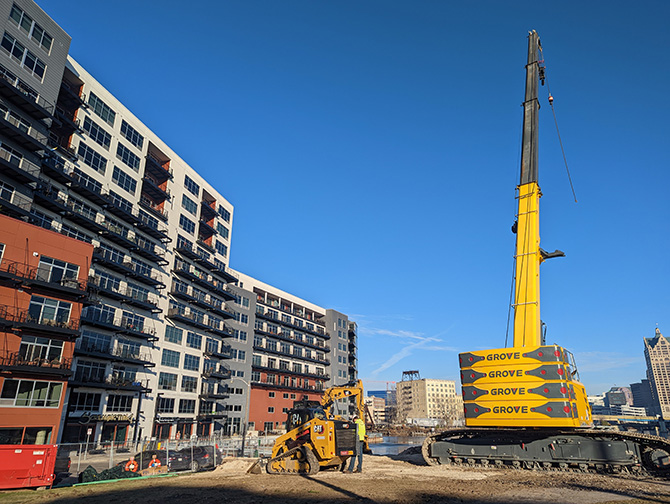By Eric Englund – Senior Natural Resources Manager and Joe Caryl – Vice President – Construction Services
City Centers – Life Blood of Communities
Urban rivers have been the life blood of many communities, providing work and prosperity for hundreds of years. Mills, tanneries, machine shops, breweries, power plants, and countless other industries have all relied on these riverways to support their operations. Their legacy continues to live through community revitalization efforts to retrofit these spaces into art galleries, restaurants, private residences, and other enterprises.
Unfortunately, part of that legacy includes industry waste that was entered into our urban waters for decades. In an effort to revitalize these critical ecosystems, we need to address impacted sediments if we want to truly restore and clean our waters.
Many city, county, state, and federal initiatives have made this effort a priority and are able to provide funding to offset costs associated with clean-up programs. Couple this with innovative sediment remediation technologies, and what you have is an opportune time to build a new legacy, one where we can look back and feel a real sense of accomplishment.
Challenges of Sediment Remediation in Urban Areas
This effort includes plenty of challenges though. Urban waterways are one of the most complex and overlooked forms of infrastructure. Used for the transport of goods, people, and for recreation, these marine highways can be just as busy as any terrestrial interstate.
In addition to the waterways themselves being highly utilized, the immediate adjacent area often includes residential buildings, restaurants, museums, art galleries, concert halls, and riverwalks. These areas are also intersected by utility lines, bridges, railways, streets, and more. Project managers of sediment remediation activities in urban areas face many potential challenges, technical and otherwise that can be broken out into the following categories.
- Stakeholder Engagement,
- Design,
- Access & Logistics, and
- Remedial Implementation.
Stakeholder Engagement
Engaging stakeholders proactively is a critical step for urban waterway projects. Often, property owners are also the “riparian rights” owners; that is, they have ownership of the waterfront (and potentially land into/under a waterway) because their property meets the shoreline. In addition to the state and federal permits necessary to perform the work, approval from these owners may also be required before any work can begin. City officials, state, and federal regulatory agencies also need to be present throughout the project. Additional requirements are often needed, whether it’s related to underwater cultural resource investigations or noise impact assessments and a review of the potential for safety concerns. Lastly, the public should be kept aware including residents, business owners, and recreational users of potential access restrictions or safety measures being implemented. Balancing this wide array of viewpoints ties into the design component.

Design
Having an effective design that minimizes impacts outside of the project footprint while addressing the contaminated sediments’ remedial objectives is a challenge for any project. In an urban setting, this becomes exponentially more difficult, but with creative solutions, we can ensure project success. One example of a solution includes combining a multitiered dredging approach with sediment containment/capping and a robust environmental/structural monitoring program.
Access & Logistics
Once the design challenges have been overcome, preparation for implementation poses the next set of hurdles. Access agreements need to be facilitated with building owners. Careful coordination must be developed with officials for public right-of-way closures. Managers must also communicate with the United States Coast Guard for boat traffic to ensure boater safety. Finding staging locations for crews to base operations and transfer resources from land to the water are needed. Lastly, community outreach to educate the public is important to minimize disruption during construction. All these steps help the project break ground, but any of these items can cause unnecessary delays in a project schedule if not accounted for and managed early on.
Remedial Implementation
Project implementation also presents many challenges. Encountering subsurface debris can impact temporary shoring installation and sediment removal, and the design should address how these issues are handled in the field. Separation and stabilization of the dredged material from river water needs to occur at generally high rates (>2,500 gallons per minute). This water needs to be treated and either discharged back into the waterway or to a municipal water treatment system, both of which generally have stringent treatment requirements and discharge limits.
Revitalization Results
The Milwaukee River Estuary Area of Concern in Wisconsin has an estimated total of ~1.4 million cubic yards of impacted material needing to be dredged. GEI is currently orchestrating the removal of ~45,000 cubic yards of this material and has helped set the level of standard needed to get this work done right. This is the beginning of decades of worth of work to return the estuary and its tributaries back into the vibrant focal points they were meant to be.
Taking urban rivers back
Cleaning up our urban waterways not only helps restore the environment but also helps restore a community’s pride. It’s not easy, but the payoff can spark a city’s economic development engine.
GEI’s history and expertise in this field has allowed us to identify and plan for each of the above challenges and successfully meet them head on. Whether related to the design components of an underwater support wall to preserve building integrity or the design of a treatment system for sediment remediation allowing clean water to be safely discharged back into Lake Michigan, our team of experts knows how to tackle large scale cleanup projects.
If you’re involved with an urban waterway project and need guidance, contact Joe Caryl, John Trast, or Eric Englund for more information.